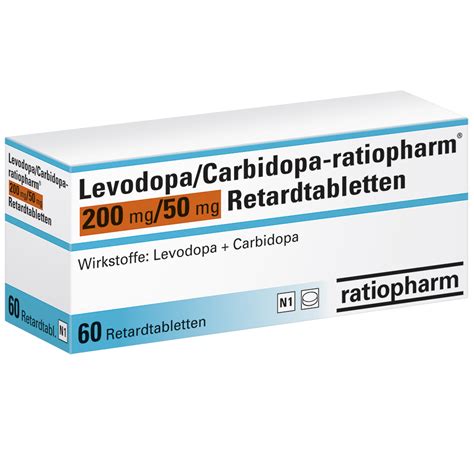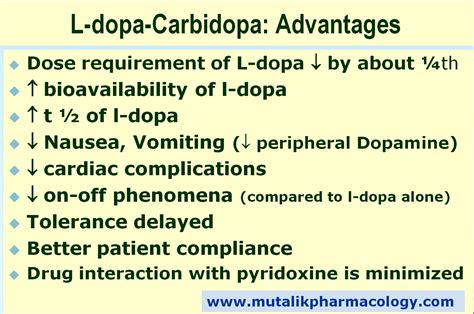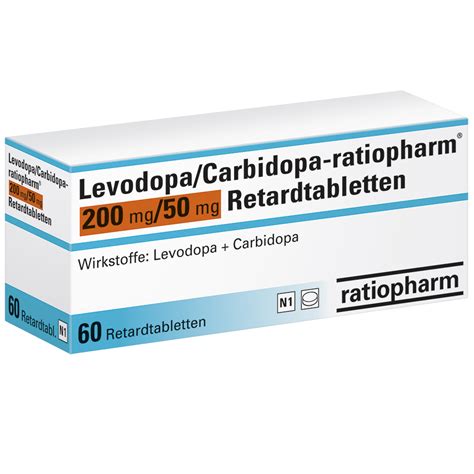Intro
Discover Carbidopa/Levodopa, a Parkinsons treatment combining carbidopa and levodopa to manage symptoms, dopamine, and motor control, improving mobility and quality of life for patients with neurodegenerative disorders.
The combination of Carbidopa and Levodopa is a crucial medication in the management of Parkinson's disease, a neurodegenerative disorder that affects movement. Parkinson's disease is characterized by the death of nerve cells, or neurons, in a part of the brain called the substantia nigra. These neurons are responsible for producing dopamine, a neurotransmitter that plays a key role in coordinating movement. The loss of dopamine-producing neurons leads to the hallmark symptoms of Parkinson's disease, including tremors, stiffness, slowness of movement, and impaired balance.
As the disease progresses, the symptoms can become more severe, significantly impacting a person's quality of life. While there is no cure for Parkinson's disease, various treatments can help manage its symptoms. Among these treatments, the combination of Carbidopa and Levodopa is one of the most effective and widely used. This medication works by increasing the levels of dopamine in the brain, thereby alleviating the symptoms of Parkinson's disease.
The importance of understanding how Carbidopa and Levodopa work, their benefits, potential side effects, and how they are used in the treatment of Parkinson's disease cannot be overstated. For individuals living with Parkinson's disease and their caregivers, having comprehensive knowledge about this medication can significantly improve disease management and overall well-being. In the following sections, we will delve into the details of Carbidopa and Levodopa, exploring their mechanism of action, benefits, and practical considerations for their use.
Introduction to Carbidopa and Levodopa

Carbidopa and Levodopa are two drugs that are always used together in the treatment of Parkinson's disease. Levodopa is a precursor to dopamine, meaning that it can cross the blood-brain barrier and be converted into dopamine in the brain. However, when Levodopa is used alone, it is rapidly converted into dopamine outside of the brain, which reduces its effectiveness and can cause side effects. Carbidopa, on the other hand, is a decarboxylase inhibitor that prevents the conversion of Levodopa into dopamine outside of the brain. By inhibiting this premature conversion, Carbidopa ensures that more Levodopa can cross into the brain, where it is needed, and be converted into dopamine, thereby increasing its efficacy and reducing side effects.
Benefits of Carbidopa and Levodopa
The combination of Carbidopa and Levodopa offers several benefits for individuals with Parkinson's disease. It is effective in managing the motor symptoms of the disease, such as tremors, rigidity, and bradykinesia (slowness of movement). By increasing dopamine levels in the brain, this medication can significantly improve mobility and reduce the risk of falls. Additionally, Carbidopa and Levodopa can enhance the quality of life for people with Parkinson's disease by allowing them to perform daily activities with greater ease and independence.How Carbidopa and Levodopa Work

The mechanism of action of Carbidopa and Levodopa is centered around the increase of dopamine levels in the brain. Levodopa crosses the blood-brain barrier and is then converted into dopamine by the enzyme dopa decarboxylase. Carbidopa, by inhibiting this enzyme outside of the brain, prevents the premature conversion of Levodopa, allowing more of it to reach the brain. Once in the brain, Levodopa is converted into dopamine, replacing the dopamine that is lost due to the death of dopamine-producing neurons in Parkinson's disease. This replacement of dopamine helps to restore the balance of neurotransmitters in the brain, which in turn alleviates the symptoms of Parkinson's disease.
Steps to Taking Carbidopa and Levodopa
To get the most benefit from Carbidopa and Levodopa, it is essential to follow the prescribed dosage and administration instructions carefully. Here are some key steps to consider: - Take the medication exactly as directed by your healthcare provider. The dosage and frequency will depend on the severity of your symptoms and how you respond to the medication. - It is usually recommended to take Carbidopa and Levodopa on an empty stomach, about 1 hour before or 2 hours after meals, to enhance absorption. - Inform your healthcare provider about all medications you are taking, including supplements and herbal products, as some can interact with Carbidopa and Levodopa. - Regular follow-ups with your healthcare provider are crucial to monitor the effectiveness of the medication and adjust the dosage as needed.Benefits and Side Effects

While Carbidopa and Levodopa are highly effective in managing Parkinson's disease symptoms, they can also cause side effects. Common side effects include nausea, dizziness, headache, and insomnia. In some cases, more severe side effects can occur, such as dyskinesia (involuntary movements) and hallucinations. It is crucial to discuss any side effects with your healthcare provider, as they can often be managed by adjusting the dosage or adding other medications.
The benefits of Carbidopa and Levodopa, however, far outweigh the risks for most people with Parkinson's disease. These benefits include:
- Improved mobility and reduced risk of falls
- Enhanced ability to perform daily activities
- Better management of motor symptoms such as tremors and stiffness
- Improved quality of life
Practical Examples and Statistical Data
Numerous studies have demonstrated the efficacy of Carbidopa and Levodopa in the treatment of Parkinson's disease. For example, a significant reduction in the severity of symptoms and an improvement in the quality of life have been reported in patients taking this medication. Statistical data also show that the combination of Carbidopa and Levodopa is more effective than Levodopa alone in managing Parkinson's disease symptoms, highlighting the importance of Carbidopa in preventing the premature conversion of Levodopa.SEO Optimization and Readability

To ensure that information about Carbidopa and Levodopa reaches those who need it, SEO optimization plays a critical role. Using relevant keywords, such as "Parkinson's disease treatment" and "Carbidopa and Levodopa," can improve the visibility of articles and websites discussing this topic. Moreover, readability is enhanced by using short paragraphs, bullet points, and numbered lists, making complex information more accessible to a wider audience.
Engagement and Sharing
We invite readers to share their experiences with Carbidopa and Levodopa, whether as individuals living with Parkinson's disease or as caregivers. Your stories and insights can provide valuable support and information to others navigating similar challenges. Please consider commenting below or sharing this article on social media platforms to help spread awareness about the effective management of Parkinson's disease with Carbidopa and Levodopa.Conclusion and Future Directions

As research into Parkinson's disease and its treatments continues, the role of Carbidopa and Levodopa is likely to evolve. Future studies may explore new formulations or combinations of these medications with other therapies to further improve symptom management and quality of life for individuals with Parkinson's disease. Meanwhile, the current evidence supports the use of Carbidopa and Levodopa as a cornerstone in the treatment of Parkinson's disease, offering hope and improved outcomes for those affected by this condition.
Final Thoughts
In conclusion, Carbidopa and Levodopa represent a significant advancement in the management of Parkinson's disease. Their ability to increase dopamine levels in the brain and alleviate symptoms has transformed the lives of countless individuals worldwide. As we look to the future, ongoing research and the development of new treatments hold promise for even better management of this condition. Until then, Carbidopa and Levodopa will remain a vital part of the treatment arsenal against Parkinson's disease.What is the primary use of Carbidopa and Levodopa?
+Carbidopa and Levodopa are primarily used in the treatment of Parkinson's disease to manage its motor symptoms by increasing dopamine levels in the brain.
How does Carbidopa work with Levodopa?
+Carbidopa inhibits the enzyme dopa decarboxylase outside of the brain, preventing the premature conversion of Levodopa into dopamine and ensuring more Levodopa reaches the brain, where it is converted into dopamine.
What are common side effects of Carbidopa and Levodopa?
+Common side effects include nausea, dizziness, headache, and insomnia. More severe side effects can occur, such as dyskinesia and hallucinations, and should be discussed with a healthcare provider.
